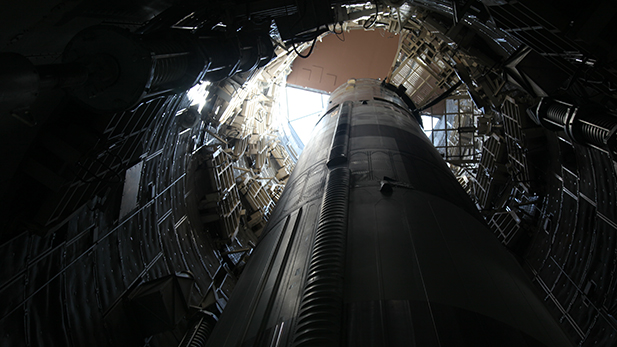 The Titan Missile is 101 feet tall. It sat in a silo that was so well insulated that the crew would not have heard it being fired from the control center.
The Titan Missile is 101 feet tall. It sat in a silo that was so well insulated that the crew would not have heard it being fired from the control center.Listen:
During the cold war, 18 intercontinental ballistic missile silos were built in the desert of Southern Arizona. They were among 54 sites built nationwide in the 1960s and decommissioned in the 1980s.
The lone site that wasn't destroyed is what became the Titan Missile Museum in Sahuarita.
On the outside, the site is fairly unremarkable, especially considering it was once home to a weapon with a blast radius of 35 miles.
“We’re standing on 10 acres of Air Force property,” said Museum Docent Karl Krumel. "And if you look over there," he said as he pointed to a structure that stands less than 10 feet above the ground, "You can see what I like to call the heart and soul of this facility. Underneath that structure is the silo, and in that silo is a Titan II missile. It’s the real thing, it’s not a model.”
A 101-foot titan two missile still stands in the silo. This particular one was used for training cadets, so it never carried any of the propulsion fuel or a the nine-megaton thermonuclear warhead that the active missile carried.
The bomb that sat inside a Titan II was tiny in comparison to the craft that carried it, which Krumel calls "a flying gas tank."
The bombs is only about eight feet long and three feet in diameter, but packed a massive explosion.
“That’s the equivalent of nine million tons of TNT. If you were to have a freight train carrying nine million tons of T-N-T, the engine would be in Tucson and the caboose would be at the Canadian border,” Krumel said.
From the time it went online, the silo was constantly staffed with by a four-person Air Force crew.
“[The crew] had two main responsibilities. One responsibility was to make sure the missile was always ready to launch,” said Yvonne Morris a former Titan II crew commander who is now the director of the Titan Missile Museum.
The other responsibility, “To launch the missile if we were ordered to do so.”
Where the missile would have gone was a secret, kept from even the crew that would have launched it.
They would have chosen one of three buttons on the command console, each designated by number.
“We don’t know today where those targets were," said Krumel. "This is still classified information, and this is 30 years after these facilities were shut down.”
Which target button to press would have been included in the launch orders given to the crew.
Those orders would have come in via radio.
They would be decoded by two crew members, who would have checked each other's work.
If that step were authenticated, the two would have opened a safe held shut with multiple locks, including one that each crew member was the only person privy to the combination.
"We don’t know each other’s combination, so we have to agree that we’re taking those locks off,” said Krumel.
That safe included further tools for verifying the orders and the keys to launch.
Among the launch orders was a six-digit code that would unlock the fueling hoses from the missile. Each digit had 16 possible options. That would be more than 16 million options, with only one right answer.
Once every order had been verified and the target was set, the soldiers would await a predesignated time, and then turn their keys.
“These keys are spring-loaded in the off position," said Krumel. "They must be turned within two seconds of each other and held for five seconds.”
Once activated, the missile would take a little less than a minute to prepare and fire.
"You might as well say welcome to World War III. Because there’s nothing we can due to stop it.”
Those inside often focused on the smaller tasks and not the over-arching duty of launching what was in its time the most destructive weapon the U.S. had ever built.
“If you spend all of your time obsessing on the potential for Armageddon, then if you’re actually called upon to launch your missile, you could be so wrapped up in that moment that you freeze,” said Yvonne Morris, who worked at the various Titan II sites in Arizona from 1980 to 1985.
She said many of the enlisted took time while in the site to study for advanced degrees or to further their military careers.
Now though, Morris' job has changed to focusing on that larger mission, making sure future generations, who never knew the looming threat of nuclear war, have a way to remember it.
“Our mission here at the museum is to provide the public with a context, a framework they can use to think about those kinds of topics and make those kinds of decisions,” Morris said.

By submitting your comments, you hereby give AZPM the right to post your comments and potentially use them in any other form of media operated by this institution.